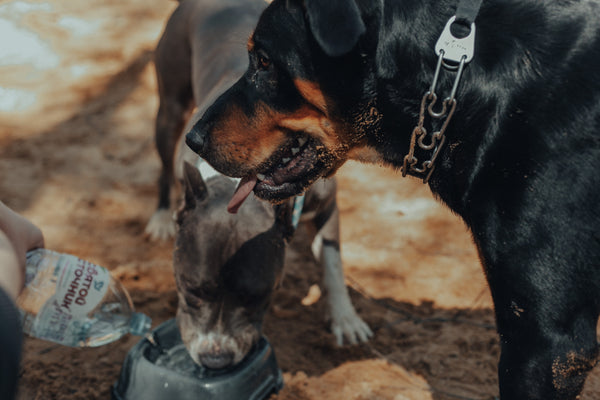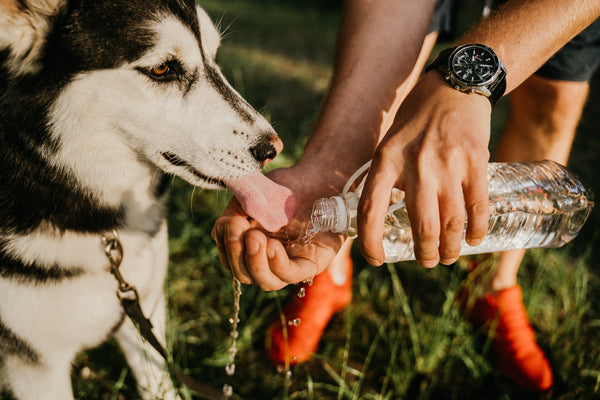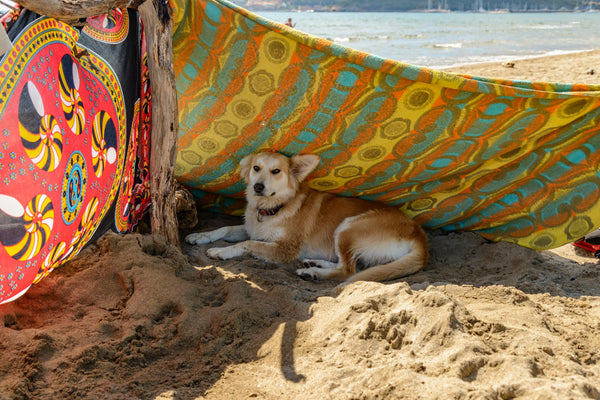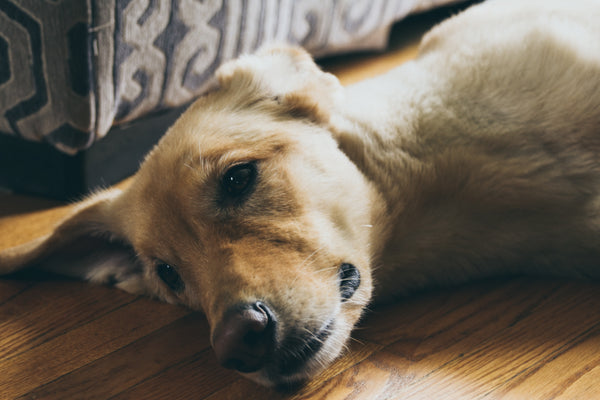Summer is a special season for us as well as our pets. Our furry friends get to spend long hours playing outdoors, going on adventures, and running around in the heat. With that comes the responsibility to keep your pet hydrated and healthy during these hot months.
Hydration is crucial for maintaining a pet's health, especially when temperatures rise. Did you know there is a whole month dedicated to national pet hydration awareness? Pet hydration awareness month works hard at educating pet owners on the importance proper hydration plays in their pet's life.
This article will provide tips on how to help your pet stay hydrated this summer and prevent dehydration. Read on to learn how you can ensure your pet stays healthy and hydrated!

Why is proper hydration important?
Proper hydration is crucial for pets for several reasons. Just like humans, pets rely on water to maintain their general health and well-being. Staying hydrated helps regulate their body temperature, aids digestion, and supports organ function.
Moreover, adequate pet hydration promotes healthy skin elasticity, coat health, and joint health and helps prevent urinary tract issues. By ensuring our pets are hydrated and that our furry friends have access to fresh and clean water at all times, we can contribute to their overall happiness and longevity.
What can happen if your pet doesn't get enough water in the summer months?
Dehydration can be a serious concern for our furry friends during the hot summer days. Without proper hydration, pets may experience symptoms such as dry mouth, lethargy, sunken eyes, and decreased appetite.
In severe cases, dehydration can lead to organ failure and even be life-threatening. It's crucial to ensure that our pets have access to fresh and clean water at all times to keep them healthy and hydrated during the summer heat.
Common Mistakes When it Comes to Pet Hydration in the Summer
Not drinking enough water
Drinking an adequate amount of water is crucial for maintaining good health and well-being. It is recommended for dogs to drink 1 ounce of water for every pound that they weigh, every day to stay hydrated and support various bodily functions.
When a pet parent overlooks the importance of daily water intake, their pets may experience symptoms such as fatigue, headaches, or dry skin as a result of dehydration. Therefore, it is essential to prioritize drinking habits and consciously incorporate sufficient water consumption into our pet's daily routines.
Drinking too much water
Drinking excessive amounts of water can lead to a condition known as water intoxication or hyponatremia. This occurs when the balance of electrolytes in the body is disrupted, potentially causing symptoms such as nausea, headache, confusion, and even seizures. It is important to find a healthy balance and not overhydrate your pets, as too much water can have negative effects on the body.
The wrong type of bowl and/or placement
Another mistake people make when it comes to pet hydration is using the wrong type of bowl or placing it in an inconvenient location. The bowls should be wide and shallow so that it's easy for pets to access their drinking water.
Moreover, it should also be placed somewhere where they can find it easily, such as near their bed or kennel. Keeping the water bowls very clean and refilling them with fresh water regularly is also essential.
Tips for Keeping Your Pet Hydrated in the Summer
Share your quality water sources.
This is key to keeping your pet hydrated in the hot summer months. Bime aware of the temperature when filling up their bowl – cold water can help cool them down in the heat. Additionally, make sure that you are changing and refilling their bowls with fresh water every day.
Consider buying a pet water fountain or using a water cooler bowl for your pets.
Water fountains and coolers are designed to keep water cooler for longer periods. This can be beneficial for pets in hot climates or hot weather, as it helps them stay hydrated without having to drink excessively cold water.
Place the water in an area away from direct sunlight and heat.
It is important to place the pet's water bowl in a spot that is shaded and away from direct sunlight. This will ensure that the water bowl always remains cool even when temperatures are high outside, making it easier for your pet to stay hydrated throughout the hot temperatures of the day.
Provide them with additional sources of hydration (i.e., wet foods).
In addition to providing your pet with access to clean and fresh water, consider adding wet food to their diet. Wet foods contain up to 80-90% moisture, which can help hydrate them even during the hottest months. Additionally, some wet foods are formulated specifically for pets who may be prone to dehydration or have specific dietary needs.
Make sure to monitor your pet’s hydration levels during the summer months, especially if they are spending extended periods outdoors.
Always be mindful of your pet's hydration levels during the summer months, especially if they are spending extended periods outdoors. Signs of dehydration include excessive panting, loss of appetite, and lethargy. If you suspect that your pet is not drinking enough water or is experiencing any other signs of dehydration during extreme temperatures, it is best to take them to the vet.
Feed your pet smaller meals more often throughout the day to help them stay better hydrated.
Pets tend to drink more water when they are fed smaller meals more often throughout the day. This can help encourage your pet to drink enough water and keep them hydrated in the summer months. Additionally, it is also important to feed them a diet that is rich in electrolytes, which can be found in both wet and dry food.
Make sure your pet has adequate shade while outside, and provide plenty of cool spots for them when they are indoors.
Make sure your pet has access to plenty of shade when they are outdoors. This can help keep them cool and protected from the sun's harsh rays. Also, provide them with a few cool spots in the house, such as a tile floor or even a damp towel. This will give them somewhere to retreat and relax during hot summer days.
Offer icy treats like ice cubes or frozen fruits.
You can also offer icy treats such as ice cubes or frozen fruits to your cats or dog to help cool your pet down while they are outside and give them a refreshing snack. This can be especially helpful if your pet is reluctant to drink water due to the temperature of the water.
Make sure your pet is getting the right amount of water each day. Some pets need more than others.
Pet parents need to remember that every pet needs different amounts of water depending on their size and breed. As a general rule, it is best to consult your veterinarian for advice on how much water your pet should be consuming each day. This will help ensure that they are getting the correct amount of hydration and not drinking excessively or too little.
Signals Your Pet is Dehydrated in the Summer
Lethargy or lack of energy.
If your pet is showing signs of lethargy or lack of energy, this could be a sign that they are not drinking enough water. This can also be accompanied by a loss of appetite and dry lips or nose. If you notice these symptoms in your pet, it is best to take them to the veterinarian for an evaluation.
Excessive panting or drooling.
Excessive panting and drooling can be an indication that your pet is not adequately hydrated. Pet owners need to monitor these signs closely, as they can be indicative of more serious medical issues if left untreated.
Decreased urine output.
Decreased urine output can also indicate that your pet is not getting enough fluids. If you notice that your pet is not urinating as much, it is best to take them to the veterinarian for an evaluation. Additionally, a decreased urine output may also be an indicator of something else- try adding some cranberry supplements to your pet’s diet and see if that helps.
Constipation or other digestive issues
Dehydration can also cause constipation or other digestive issues in pets. Monitor your pet's diet and water consumption if they are experiencing any of these issues. If the symptoms persist, it is best to take them to the veterinarian for a checkup.
Dry skin or coat
Dry skin or coat can also be an indication of dehydration in pets. Monitor your pet's water intake and ensure that they are drinking enough fluids throughout the day.
Overall, make sure that they are on a diet that is rich in essential fatty acids, which can help keep their skin and coat healthy. Adding supplements such as omega-3 will help maintain a shiny and healthy coat.
Loss of appetite or weight loss
Loss of appetite and weight loss can also be a sign that your pet is not adequately hydrated. Monitor their water consumption and make sure that they are getting enough fluids throughout the day. Additionally, take them to the veterinarian for a checkup if you notice any changes in their behavior, body weight, or eating habits.
Dark colored urine
Dark-colored urine is another indication of dehydration in pets. Monitor your pet's water intake and make sure they are drinking enough fluids throughout the day. Additionally, consider adding electrolyte supplements to their diet if you notice that they have difficulty staying hydrated.
Conclusion
Keeping your pet hydrated is essential during the summer months. Make sure you are aware of common mistakes when it comes to pet health and hydration, and take all necessary measures to ensure your pet has access to fresh, clean water at all times. Be mindful of any signs that your pet might be dehydrated, and take them to the veterinarian if needed.
















